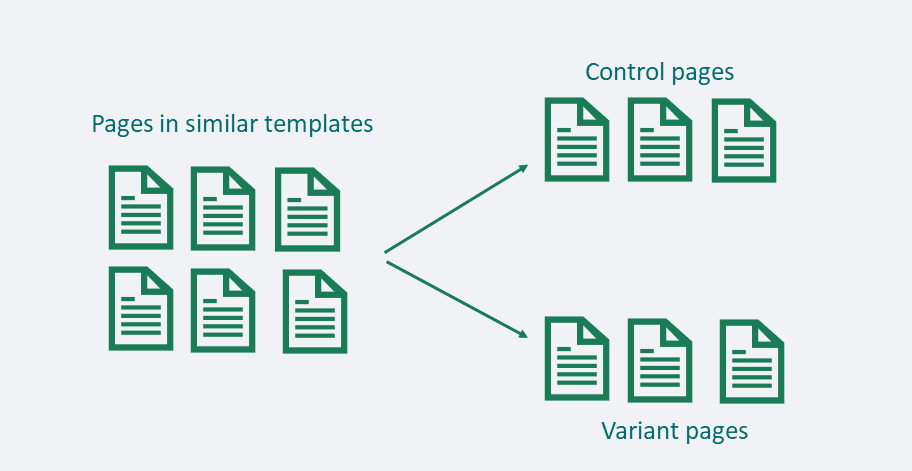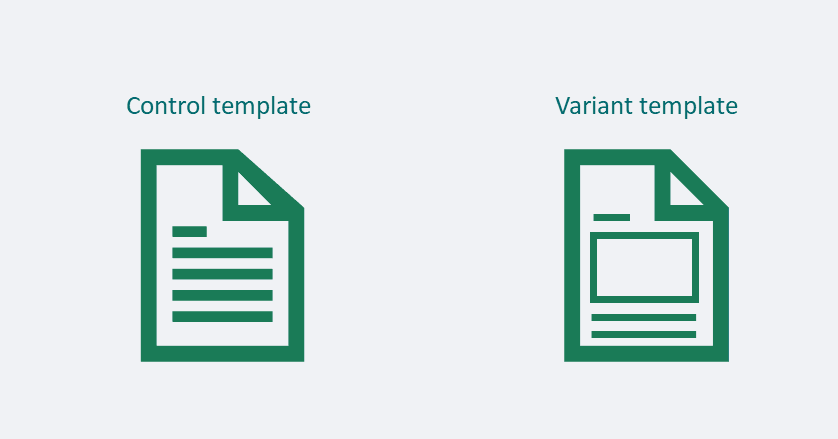One of the bigger challenges companies face when they take their business online is visibility. Particularly, the lack of it.
With millions of web pages floating around Google, it feels impossible to get even one foot in the door and show up on results pages, let alone rank high. We won’t sugarcoat things —it is difficult, which is why the sooner a business can reach out to an advertising agency for help, the better.
Many see agency SEO services as some kind of magic or a happy stroke of luck that can help their websites perform better overnight. The truth is, SEO is strategic engineering. Search engine optimisers run experiments, collect and analyse data, and run more experiments until we get optimal results.
One of the methods through which they run these experiments is the SEO A/B test.
WHAT IS A/B TESTING IN SEO?
SEO A/B testing is the optimisation of web page elements through before and after testing. This is done with the final goal of testing being to increase visibility in SERPs (Search Engine Results Pages) and to achieve a higher average ranking and number of organic sessions. In SEO, A/B testing answers to search engine algorithms instead of user preferences.
For example, a business that wants to start ranking on Google results pages may take a closer look at Google algorithms and tweak elements on or in its website pages to best appeal to those algorithms.
Testing requires pages of a website that have a similar template and similar metrics to be split into two batches – one that remains exactly the same, and the other on which changes will be implemented. These are known as the control and variant pages, respectively.

Due to the fact that pages are ‘split’ into two piles, SEO A/B testing is also called SEO split testing. These two terms will be used interchangeably in this post.
THE PROCESS OF A/B TESTING IN SEO
This brings us to the next question—how does one actually A/B test in SEO? What are the steps involved, and what precautions should testers make to make the most out of it? Below is an outline of the fundamental steps each test involves.
1. SELECT TESTING PAGES
First, you must select the group of pages on your website you want to test on.
These must be pages in the same template, and it is optimal that there are at least hundreds of them as it will make data collection and comparison much easier.
What do you mean ‘in the same template’?
It simply means that these pages look similar and often serve the same purpose. For eCommerce site owners, these may be their product pages, while for websites such as eBay and Craigslist, these may be their listing pages. Long-form articles within the same section of large content hubs count too, and so do hotel suite booking pages on hospitality websites.
The closer these pages are to each other in terms of format, and the more pages there are for testing, the better.
The pages should also have historical data of a few hundred days, preferably at least a year, so that any trends in traffic throughout the year have been stabilised and can be used in data forecast and analysis.
2. CREATE A HYPOTHESIS
Next, you must create a hypothesis for your A/B test.
A hypothesis is a prediction of the results of your experiment. Since your goal is to increase visibility on SERPs, the best SEO A/B hypotheses are grounded in what you already know about the search engine you want to rank on, and what you already know about your own web pages.
For example, you are a local business looking to rank higher on Google ought to familiarise themselves with Google’s search algorithms. One of the elements Google cares about is the relevance of webpages, and a way to ‘become relevant’ is through improving page content.
Knowing this, you hypothesise that providing high quality content that matches user search intent can increase the relevancy of your page and increase rankings on SERPs, which will likely increase organic sessions.
From here, you create a new template for your pages with new and diversified content copy that includes relevant keywords, high quality text, or even video and pictures to test out your hypothesis. You also create a forecast of the kind of traffic you expect these changes will get you while keeping your expectations realistic.
3. SEPARATE PAGES INTO CONTROLS AND VARIANTS
With a solid hypothesis founded, you can start dividing your test pages into controls and variants.
How you divide them is up to you. However, it is important to refer to historical data of how the pages have been performing and make sure each set of pages have similar trends and levels of traffic. It would also certainly make sense to consider external influences that could impact the results of your data and plan accordingly.
For example, if you are testing your travel website and in particular your flight destination pages, it would make sense to factor in seasonality. Travellers generally like to go on beach holidays in the Summer and take ski trips in the Winter.
By placing all beach destinations as control pages and all ski lodge destinations as variant pages, it is likely that you will get biased results based on the season in which you conduct your test.
4. IMPLEMENT CHANGES
Next, you can implement the changes you had in mind onto the ‘variant’ pages and leave the ‘control’ pages unchanged.
This leaves you with two sets of live pages that adhere to two different formats at the same time.

These are different pages that host different content. You should never have two versions of the same page live on your site, as this will affect the outcome of your test.
5. GATHER AND ANALYSE RESULTS
After sufficient time has elapsed, measurements such as the actual number of clicks from SERPs, and clickthrough rate of both the control and variant pages can be taken and compared to those of their respective forecasts.
This can be done on a daily basis.
Each day, you set the forecasted control traffic and then check if the actual control traffic measures up to it. Based on that result, you set the forecasted variant traffic and then check if the actual variant traffic measures up to it.
By analysing your results in this order, you can make adjustments to your forecasted variant traffic each day based on whether there is a rise or a dip in your control traffic, which could likely be attributed to external influences such as seasonality or trend. This helps you minimise the impact of external factors on your data as much as possible.
The experiment is considered a positive test if its results fulfil two elements.
Firstly, if the trend of the actual variant traffic is considerably higher than the forecasted variant traffic. Secondly, if the trend of the actual variant traffic is considerably higher than that of the actual control traffic.
If the results do not fulfil either criterion, you can nip the test in the bud and revert the changes made on the variant pages.
If the results are inconclusive or any statistical differences recorded are not large enough to be significant, it may be worth running the experiment again, this time making different tweaks.
A LITTLE MORE ON A/B TESTING IN SEO
WHO CAN PARTICIPATE IN TESTING?
Even though technically anybody can participate in SEO A/B testing, there is a set criterion that websites are recommended to have met in order to reap the best results.
Firstly, websites being tested should have sufficient and stable organic traffic in the first place. This usually points to websites that have a few tens of thousands of organic sessions, so that when testing is in place, changes can be easily spotted and can easily acquire statistical significance.
Secondly, websites being tested should have at least hundreds of pages in a similar template for testing. This is because half of them will have to be set aside as ‘variant’ pages during testing and the other half will have to be kept as ‘control’ pages. So the more pages you have available, the easier it will be to collect enough data and rule out anomalies.
WHAT CAN I TEST?
Almost any page element can be tested; it is all dependent on your company’s specific goals, direction, budget, and, particularly, level of SEO expertise.
This is why it is very common for a business to outsource to an SEO marketing company—having an expert in the field makes a world of difference and opens up doors when it comes to A/B testing in SEO.
For starters, testers may choose to experiment with ‘simpler’ elements such as title tags, meta descriptions, and H1 headers. These are immediately visible to anybody who comes across your website on SERPs and clicks into your site. Trying out different word placements is a good way to find out which one will appeal to Google the best.
For example, following SEO best practices, brand names can be placed at the end of title tags for clarity. Meta descriptions can be pruned or extended, and H1 headers can be made visible in the site homepage and keyword optimised. All of this can help Google pick up cues on what your business is about and put your website in its good books.
Intermediate testers with knowledge of HTML and CSS can focus on more complex elements and do structure testing on pages. These include data tests such as breadcrumb and review markups.
Finally, advanced SEO strategists with a strong understanding of coding and A/B testing methodologies can experiment with internal linking tests and reorder site structures in accordance with SEO best practices.
The littlest changes made through SEO A/B testing has the ability to create huge improvements in organic traffic performance. And though the testing process is based on a simple framework, it can get quite complex indeed. Because of this, businesses often find that the expertise of an SEO team is not just helpful, but crucial, in helping their websites shine.
WHAT IS THE BEST TIMEFRAME FOR TESTING?
As with all SEO-related endeavours, results take time, and the amount of time varies depending on your business goals and the size and scope of your testing.
After implementing changes, trends in data can start emerging within a week if there are no complications. However, it is expected that SEO testing should take 2-4 weeks for these trends to gain statistical significance and stabilise.
WHAT IS T9HE DIFFERENCE BETWEEN SEO AND USER A/B TESTING?
If you have dabbled in A/B testing, you may have found yourself wondering why the explanation above sounds a little different from those ones you have heard before.
This is because there are different types of testing, and the one you have had in mind may have been User A/B testing. User A/B testing uses a similar technique, where variants of web pages are created and tested with a hypothesis. However, there are a few key differences between the two.
AIMS AND OBJECTIVES
A/B testing in SEO aims to tweak webpage elements to appeal to search engine algorithms, with efforts to rank higher and become more visible in SERPs. The main objectives are generally to increase organic traffic and click-through rates.
User A/B testing, on the other hand, is catered towards human users and their preferences, and tests are generally geared towards improving user experience. The main objectives are usually more user-based as well, such as an increase of conversions in addition to organic traffic.
CONTROLS AND VARIANTS
In SEO testing, as we have seen, pages are split into two sets—controls and variants. Changes are made only to the variant pages, and data collected are compared to a previously determined performance forecast.
In User testing, two versions of the same page are set up and run live at the same time, and human users are redirected to a random one. Thus, it is the users themselves that are split into controls and variants. Data is collected from how users interact with the version of the page they are assigned to and compared.
VERSIONS OF THE PAGES
In SEO split testing, there is only one version of each page at any time. With Google as the determiner of how these pages will rank, duplicated content (which Google is against) is not encouraged.
This means that you cannot be showing one version of a page to appeal to search engine algorithms and another to appeal to your users. This is called cloaking, and it is against Google guidelines. Cloaking can get your website demoted in rankings or even removed completely, depending on the severity of the offence.
User testing, on the other hand, requires two versions of the same page to be live at the same time so data can be collected and compared.
WHY A/B TEST
People perform split testing within sections of a website with the aim to increase organic sessions and page rankings in search engines. When done right, the major benefit is that visibility will improve across pages.
But if we want results, why not just do some research, and then revamp the entire website in one go?
Tampering with your entire website based on unproven theories is a waste of your time at best, and at worst, a recipe for disaster.
Firstly, for large eCommerce sites or content-hosting platforms with hundreds or thousands of pages, it will take time to revamp the entire site. This downtime will hurt your organic traffic and inconvenience your users.
Secondly, research is theoretical. While there is nothing wrong with theories, we are going to need more than that to justify making practical changes. Within SEO, theories do not always translate well into real life, and the only sure-fire way to know if something will work is if we put it to test and obtain proof in the form of data.
SEO split testing is a great way to get that data. As testing can also be done on a smaller scale, focusing on a set category of pages at one time and leaving the rest of the site untouched, it allows for pages to be optimised with minimal disruption of the site’s flow.
Should testing results meet expectations, changes can be rolled out and implemented sitewide. Should they not, changes can be reverted with little hassle. This saves time and effort, and it avoids the risk of wreaking irreversible havoc.
THE BOTTOM LINE
Running an SEO A/B test is hugely beneficial for businesses that want to expand their digital presence. The right tweaks in alignment with search engine algorithmic preferences can help your website become more visible on SERPs and increase organic traffic.
One thing to keep in mind when testing is that although SEO is vital in drawing in users, what ultimately persuades them to stay depends on other factors, such as user experience, content quality, and company branding. Therefore, it is important that your website not only hits all the spots with the search engine but also make efforts to connect with human users.
MediaGroup offers a range of SEO services alongside other digital marketing solutions such as PPC and social media advertising, content creation, and general consultancy. Contact us today to discuss the best options for your business.
Popular categories:
The Memorable Marketing by MediaGroup podcast series interviews leading senior marketers worldwide on all things marketing, campaigns, strategy, building awareness and everything that makes a brand successful.
Join the conversation by leaving your thoughts and questions, and we will be happy to chat with you. If you want to discuss your business marketing strategies in more detail or join our podcast as a guest, please reach out to us at: info@mediagroupww.com
Latest Insights
Article
Evergreen Content: The forgotten hammer in your SEO strategy toolbox?
Opting for Evergreen Content (EGC) as part of an effective SEO strategy is not an either/or scenario. You can proceed with your existing content plan and introduce an EGC strategy for generous increases in your ROI.
Written by Clarissa Siu
Quarterly marketing insights in our newsletter
We are committed to helping you get the best results in your digital marketing game. Our experts will give you actionable insights and knowledge, based on our experience, to tackle the biggest marketing challenges. Unsubscribe at any time.
Mediagroup Worldwide processes the above information in order to subscribe you to the newsletter. Privacy Policy
